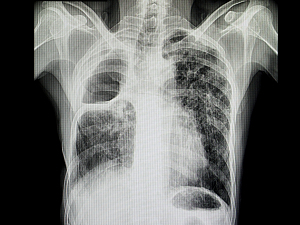Multiple scoring systems are available to predict prolonged air leaks (PAL) after lung resection, commonly defined as those lasting five days or more. However, a study recently published in Seminars in Thoracic and Cardiovascular Surgery showed a high risk of false positives and low positive predictive value for four commonly used models.
Even less is known about severe PAL that requires intervention. Researchers at Brigham and Women’s Hospital retrospectively studied a large series of patients undergoing lung resection to determine the incidence of severe PAL and its risk factors.
Matthew M. Rochefort, MD, thoracic surgeon in the Brigham’s Division of Thoracic and Cardiac Surgery, Aaron R. Dezube, MD, research fellow in the division, and colleagues reported the results in Interactive Cardiovascular and Thoracic Surgery.
Methods
The team analyzed data on all 2,384 patients (median age 67, 59% female) who underwent primary wedge resection (56%), lobectomy (32%), or segmentectomy (12%) at the Brigham between May 2016 and December 2019. 84% had open video-assisted thoracoscopic surgery (VATS) while 12% had thoracotomies and 4% had robotic-assisted thoracoscopic surgery (RATS).
Incidence of PAL and Severe PAL
129 patients (5.4%) developed PAL, of whom 29 (1.2% of the entire cohort) had severe PAL requiring intervention.
Interventions for severe PAL consisted of reoperations in 16 patients (55%), chest tubes in nine (31%), and percutaneous drains in four (14%). Three patients still had a concern for an air leak at the end of the initial intervention and required placement of a pericardial fat pad, intercostal muscle flap or pleural tent.
Fifteen of the 29 patients who underwent intervention (52%) required a Pneumostat at discharge.
Factors Affecting PAL Risk
In a multivariable model, risk factors for PAL were:
- Lobectomy—OR, 3.76 vs. wedge resection (P<0.001)
- Segmentectomy—OR, 2.41 vs. wedge resection (P=0.004)
Protective factors were:
- RATS—OR, 0.24 vs. thoracotomy (P=0.022)
- Female sex—OR, 0.51 (P<0.001)
Factors Affecting Severe PAL Risk
Because of the low rate of severe PAL, the researchers conducted only a univariable analysis to assess risk factors for severe PAL, which were:
- Albumin <3—OR, 11.04 (P=0.041)
- Diffusion capacity for carbon monoxide <50%—OR, 10.00 (P=0.002)
- Preoperative forced expiratory volume in 1 second <40%—OR, 4.74 (P=0.028)
- Steroid use—OR, 3.66 (P=0.023)
Considerations for Surgeons
When possible, patients with risk factors for severe PAL should be referred for “prehabilitation” (exercise-based interventions prior to lung resection). Most indications for lung cancer surgery are too time-sensitive to allow prehabilitation, though.
Instead, the high-risk factors identified here could be used to determine which patients need earlier surgery. In addition, they can identify patients at low risk of PAL who can expect to be discharged with conservative outpatient management.
